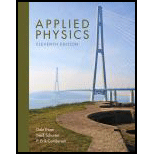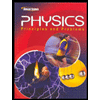
Applied Physics (11th Edition)
11th Edition
ISBN: 9780134159386
Author: Dale Ewen, Neill Schurter, Erik Gundersen
Publisher: PEARSON
expand_more
expand_more
format_list_bulleted
Concept explainers
Textbook Question
Chapter 20.3, Problem 16P
An AM radio station broadcasts a signal with a wavelength of 237 m. Find its frequency in kHz.
Expert Solution & Answer
Want to see the full answer?
Check out a sample textbook solution
Students have asked these similar questions
How long is the wavelength of a wave whose frequency is 282 Hz and travels with a speed of 343 m/s?
What is the speed of a sound wave that has a frequency of 146.68 Hz and a wavelength of 2.34 m?
What is the intensity of 60db?
Chapter 20 Solutions
Applied Physics (11th Edition)
Ch. 20.2 - Find the distance (in metres) traveled by a radio...Ch. 20.2 - Prob. 2PCh. 20.2 - A television signal is sent to a communications...Ch. 20.2 - How long does it take for a radio signal from the...Ch. 20.2 - The sun is 9.30107mi from the earth. How long does...Ch. 20.2 - A radar wave is bounced off an airplane and...Ch. 20.2 - How long does it take for a radio wave to travel...Ch. 20.2 - How long does it take for a flash of light to...Ch. 20.2 - How long does it take for a police radar beam to...Ch. 20.2 - How far away (in km) is an airplane if the radar...
Ch. 20.2 - An auto mechanic uses a strobe light to time a...Ch. 20.2 - A construction company uses GPS technology to...Ch. 20.2 - (a) How long does it take for light to reach the...Ch. 20.2 - Prob. 14PCh. 20.2 - How long does it take light to reach the earth...Ch. 20.2 - Preparing for reentry, astronauts use radar to...Ch. 20.2 - Prob. 17PCh. 20.2 - Light from the sun travels 1.50108 km to reach the...Ch. 20.3 - c=3.00108m/s =4.55105m f=?Ch. 20.3 - c=3.00108m/s =9.701010m f=?Ch. 20.3 - c=3.00108m/s f=9.701011Hz =?Ch. 20.3 - c=3.00108m/s f=24.2 MHz =?Ch. 20.3 - c=3.00108m/s f=45.6 MHz =?Ch. 20.3 - Prob. 6PCh. 20.3 - Prob. 7PCh. 20.3 - Prob. 8PCh. 20.3 - Find the wavelength of a radio wave from an AM...Ch. 20.3 - Find the wavelength of a radio wave from an FM...Ch. 20.3 - Find the frequency of an electromagnetic wave if...Ch. 20.3 - Find the frequency of an electromagnetic wave if...Ch. 20.3 - Prob. 13PCh. 20.3 - Prob. 14PCh. 20.3 - Prob. 15PCh. 20.3 - An AM radio station broadcasts a signal with a...Ch. 20.4 - Prob. 1PCh. 20.4 - Prob. 2PCh. 20.4 - Prob. 3PCh. 20.4 - Find the frequency of electromagnetic radiation...Ch. 20.4 - Find the frequency of electromagnetic radiation...Ch. 20.4 - Prob. 6PCh. 20.4 - Find the frequency of electromagnetic radiation...Ch. 20.4 - Prob. 8PCh. 20.4 - Prob. 9PCh. 20.4 - Prob. 10PCh. 20.4 - Prob. 11PCh. 20.4 - Prob. 12PCh. 20.4 - An AM radio station in a nearby town broadcasts a...Ch. 20.5 - I=48.0 cd I=___mCh. 20.5 - Prob. 2PCh. 20.5 - I=765 m I=___ cdCh. 20.5 - I=432 m I=___ cdCh. 20.5 - I=75.0 cd I=___ mCh. 20.5 - I=650 m I=___ cdCh. 20.5 - I=900 m r=7.00 ft E=?Ch. 20.5 - I=741 m r=6.50 m E=?Ch. 20.5 - I=893 m r=3.25 ft E=?Ch. 20.5 - E=4.32 lux r=9.00 m I=?Ch. 20.5 - E=10.5 ft-candles r=6.00 ft I=?Ch. 20.5 - Prob. 12PCh. 20.5 - Prob. 13PCh. 20.5 - Prob. 14PCh. 20.5 - If an observer triples her distance from a light...Ch. 20.5 - If the illuminated surface is slanted at an angle...Ch. 20.5 - Find the illumination on a surface by three light...Ch. 20.5 - Find the intensity of two identical light sources...Ch. 20.5 - Find the intensity of two identical light sources...Ch. 20.5 - A desk is 3.35 m below an 1850-m incandescent...Ch. 20 - Which of the following are examples of...Ch. 20 - Prob. 2RQCh. 20 - Prob. 3RQCh. 20 - Light behaves a. as a massive particle. b. always...Ch. 20 - Does the wavelength of light depend on its...Ch. 20 - Prob. 6RQCh. 20 - How does the intensity of illumination depend on...Ch. 20 - In your own words, explain how the speed of light...Ch. 20 - Does light always travel at the same speed?...Ch. 20 - What name is given to the entire range of waves...Ch. 20 - Prob. 11RQCh. 20 - Who developed the wave packet theory of light?Ch. 20 - Who made the first estimate of the speed of light?Ch. 20 - How was the first estimate of the speed of light...Ch. 20 - What are the units of luminous intensity?Ch. 20 - In your own words, explain luminous intensity.Ch. 20 - Find the distance (in metres) traveled by a radio...Ch. 20 - A radar wave that is bounced off an airplane...Ch. 20 - How long does it take for a police radar beam to...Ch. 20 - Prob. 4RPCh. 20 - How long does it take for a radio signal to travel...Ch. 20 - Find the wavelength of a radio wave from an AM...Ch. 20 - Find the frequency of a radio wave if its...Ch. 20 - Prob. 8RPCh. 20 - Prob. 9RPCh. 20 - Prob. 10RPCh. 20 - Prob. 11RPCh. 20 - Prob. 12RPCh. 20 - Prob. 13RPCh. 20 - Find the intensity of the light source necessary...Ch. 20 - Prob. 15RPCh. 20 - Find the intensity of two identical light sources...Ch. 20 - Find the illumination on a surface by three light...Ch. 20 - Prob. 1ACCh. 20 - (a) When the Apollo astronauts landed on the moon,...Ch. 20 - Prob. 3ACCh. 20 - The individual rods on rooftop antennas are...Ch. 20 - Prob. 5AC
Additional Science Textbook Solutions
Find more solutions based on key concepts
Your RL circuit has a characteristic time constant of 20.0 ns, and a resistance of 5.00 M (a) What is the indu...
College Physics
The pressure unit torr is defined as the pressure that will support a column of mercury 1 mm high. Meteorologis...
Essential University Physics: Volume 1 (3rd Edition)
If you painted positive charge on the floor, what surface charge density would be necessary to suspend a 15C, 5...
Essential University Physics: Volume 2 (3rd Edition)
The Sun is approximately 6000 K at the surface and has an energy distribution that peaks at visible wavelengths...
Lecture- Tutorials for Introductory Astronomy
Predict the relative brightness of bulbs B1,B1,andB3 in the circuits shown. (A dashed box has been drawn around...
Tutorials in Introductory Physics
22.(I) A car slows down from 28 m/s to rest in a distance of 88m. What was its acceleration, assumed constant?
...
Physics: Principles with Applications
Knowledge Booster
Learn more about
Need a deep-dive on the concept behind this application? Look no further. Learn more about this topic, physics and related others by exploring similar questions and additional content below.Similar questions
- The range of frequencies used for medical applications includes 1,599,360 Hz. What is the wavelength of this frequency in air at a temperature of 20.0°? λ = _______ ×10marrow_forwardThe wavelength of a certain frequency of light is 5 x 10-7 meters. If the speed of light is 300,000 km/sec, the frequency of the light is ____ hertz.arrow_forwardFind v, the speed of the sound waves in air express in meters per second to three significant figuresarrow_forward
- A light wave has a frequencey of 1.2 X 1010 Hz. What is the wavelength (in meters) of this light?arrow_forwardIgnore my answer Answer clearlyarrow_forwardThe frequency of an electromagnetic wave is 11371 Hz. What is the wavelength of the light in meters? Round your answer to 1 decimal place.arrow_forward
arrow_back_ios
SEE MORE QUESTIONS
arrow_forward_ios
Recommended textbooks for you
 Glencoe Physics: Principles and Problems, Student...PhysicsISBN:9780078807213Author:Paul W. ZitzewitzPublisher:Glencoe/McGraw-Hill
Glencoe Physics: Principles and Problems, Student...PhysicsISBN:9780078807213Author:Paul W. ZitzewitzPublisher:Glencoe/McGraw-Hill

Glencoe Physics: Principles and Problems, Student...
Physics
ISBN:9780078807213
Author:Paul W. Zitzewitz
Publisher:Glencoe/McGraw-Hill
What Are Sound Wave Properties? | Physics in Motion; Author: GPB Education;https://www.youtube.com/watch?v=GW6_U553sK8;License: Standard YouTube License, CC-BY